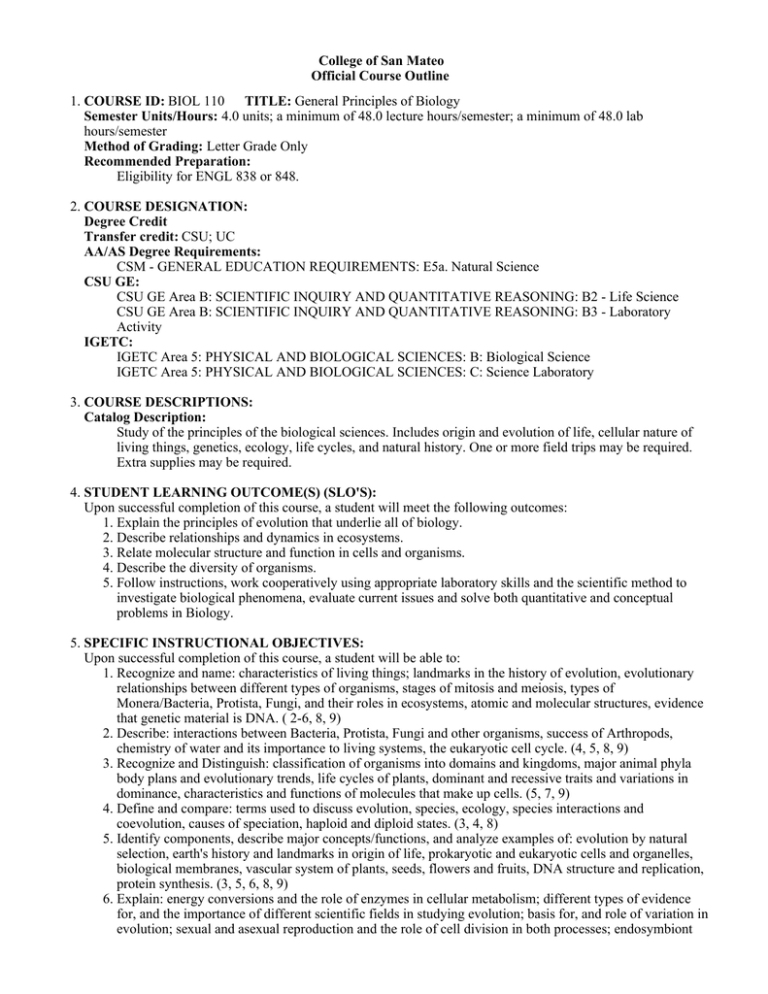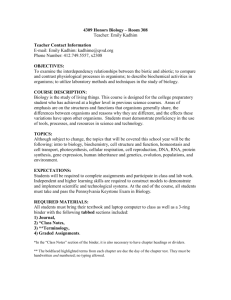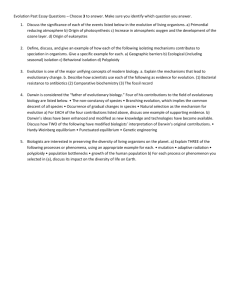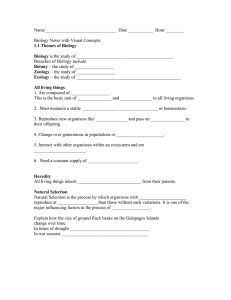College of San Mateo Official Course Outline COURSE ID: Semester Units/Hours:
advertisement

College of San Mateo Official Course Outline 1. COURSE ID: BIOL 110 TITLE: General Principles of Biology Semester Units/Hours: 4.0 units; a minimum of 48.0 lecture hours/semester; a minimum of 48.0 lab hours/semester Method of Grading: Letter Grade Only Recommended Preparation: Eligibility for ENGL 838 or 848. 2. COURSE DESIGNATION: Degree Credit Transfer credit: CSU; UC AA/AS Degree Requirements: CSM - GENERAL EDUCATION REQUIREMENTS: E5a. Natural Science CSU GE: CSU GE Area B: SCIENTIFIC INQUIRY AND QUANTITATIVE REASONING: B2 - Life Science CSU GE Area B: SCIENTIFIC INQUIRY AND QUANTITATIVE REASONING: B3 - Laboratory Activity IGETC: IGETC Area 5: PHYSICAL AND BIOLOGICAL SCIENCES: B: Biological Science IGETC Area 5: PHYSICAL AND BIOLOGICAL SCIENCES: C: Science Laboratory 3. COURSE DESCRIPTIONS: Catalog Description: Study of the principles of the biological sciences. Includes origin and evolution of life, cellular nature of living things, genetics, ecology, life cycles, and natural history. One or more field trips may be required. Extra supplies may be required. 4. STUDENT LEARNING OUTCOME(S) (SLO'S): Upon successful completion of this course, a student will meet the following outcomes: 1. Explain the principles of evolution that underlie all of biology. 2. Describe relationships and dynamics in ecosystems. 3. Relate molecular structure and function in cells and organisms. 4. Describe the diversity of organisms. 5. Follow instructions, work cooperatively using appropriate laboratory skills and the scientific method to investigate biological phenomena, evaluate current issues and solve both quantitative and conceptual problems in Biology. 5. SPECIFIC INSTRUCTIONAL OBJECTIVES: Upon successful completion of this course, a student will be able to: 1. Recognize and name: characteristics of living things; landmarks in the history of evolution, evolutionary relationships between different types of organisms, stages of mitosis and meiosis, types of Monera/Bacteria, Protista, Fungi, and their roles in ecosystems, atomic and molecular structures, evidence that genetic material is DNA. ( 2-6, 8, 9) 2. Describe: interactions between Bacteria, Protista, Fungi and other organisms, success of Arthropods, chemistry of water and its importance to living systems, the eukaryotic cell cycle. (4, 5, 8, 9) 3. Recognize and Distinguish: classification of organisms into domains and kingdoms, major animal phyla body plans and evolutionary trends, life cycles of plants, dominant and recessive traits and variations in dominance, characteristics and functions of molecules that make up cells. (5, 7, 9) 4. Define and compare: terms used to discuss evolution, species, ecology, species interactions and coevolution, causes of speciation, haploid and diploid states. (3, 4, 8) 5. Identify components, describe major concepts/functions, and analyze examples of: evolution by natural selection, earth's history and landmarks in origin of life, prokaryotic and eukaryotic cells and organelles, biological membranes, vascular system of plants, seeds, flowers and fruits, DNA structure and replication, protein synthesis. (3, 5, 6, 8, 9) 6. Explain: energy conversions and the role of enzymes in cellular metabolism; different types of evidence for, and the importance of different scientific fields in studying evolution; basis for, and role of variation in evolution; sexual and asexual reproduction and the role of cell division in both processes; endosymbiont hypothesis of eukaryote evolution. (3, 5, 8) hypothesis of eukaryote evolution. (3, 5, 8) 7. Distinguish and compare processes of: energy flow and mass cycling in ecosystems, advantages and problems of aquatic and terrestrial life for plants and animals, four major plant groups and evolutionary trends, classes of vertebrates and evolutionary trends, photosynthesis and aerobic respiration, structure and function of DNA and RNA, types and consequences of mutation. (4-6, 9) 8. Apply rules to solve problems illustrating: use of the genetic code, Mendelian genetics. (6, 7) 9. Demonstrate basic laboratory skills for objective investigation of biological phenomena: use of light microscope, tools for metric measurement of length and volume, accurate observation and recording of results, cooperative group preparation, results and analysis of simple exercises using the scientific process.(Laboratory topics) 10. Recognize: scientific approach to investigating phenomena; unifying theme of evolution in biology, importance of science in society's decisions. (1, 3, 4) 11. Communicate explanations of biological phenomena in writing. (All lecture and lab topics) 6. COURSE CONTENT: Lecture Content: 1. Scientific method (1 lecture + numerous examples over semester) 2. Characteristics of Life (1 lecture) 3. Evolution-terms, fundamental concepts, examples (2-3 weeks + part of all topics) A. Landmarks in history of evolutionary theory; evidence for evolution B. Principle of Natural Selection C. Adaptations, populations, species, sympatric & allopatric speciation D. Microevolution, macroevolution processes, mechanisms, importance of variation E. Origin of Life: earth's history, chemical evolution, levels of organization F. Prokaryotic and eukaryotic domains, kingdoms, evolutionary relationships; endosymbiont hypothesis of eukaryote evolution; evolution of multicellular organisms 4. Ecology-terms, fundamental concepts, examples (1-2 weeks) A. Community, abiotic, biotic environment, niche, producer, consumer, trophic levels B. Energy flow, mass cycles, food webs & pyramids C. Species interactions, coevolution 5. Chemistry (2-3 weeks + lab) A. Atomic and molecular structure B. Water chemistry, importance to living systems C. Molecules of cells; interactions with water, organic substances, basic structure and characteristics of carbohydrates, lipids, proteins, nucleic acids D. Proteins: diverse functions, information content/specificity E. Energy conversions: metabolic pathways, role of enzymes in cell metabolism F. Photosynthesis, Cellular respiration 6. Molecular Biology (2-3 weeks) A. DNA structure, replication B. RNA, genetic code C. Protein synthesis D. Mutation 7. Mendelian inheritance- terms, fundamental concepts, examples (1 week + lab) 8. Cells (2 weeks + lab) A. General characteristics, prokaryotic structure, eukaryotic organelles B. Membrane structure and function; transport C. Cell division and organismal reproduction: asexual and sexual reproduction, mitosis, meiosis, haploid, diploid cells 9. Survey of traditional five kingdoms and three domains (6 weeks) A. Metabolic diversity, roles in ecosystems, interactions with humans, of Monera (Bacteria & Archaea), Eukarya: Protista, Fungi, Plants, Animals B. Advantages, problems of aquatic and terrestrial living for algae/plants, animals C. Plants: trends in evolution, characteristics of four major groups, seeds, flowers, fruits D. Animals: trends in evolution, characteristics of major phyla; Vertebrates trends in evolution, characteristics of classes Lab Content: Course content-laboratory topics (15-17 per semester) 1. Observation: Scientific Method 2. Use of the Microscope; Metric Units; Cells and tissues 3. Mitosis and Meiosis 4. Osmosis and Diffusion 5. Biochemistry, Nutrition 6. Metabolism: Enzymes, Fermentation, Respiration, Photsynthesis 7. Bacterial Plating 8. Survey of the Animal Kingdon 9. Survey of the Plant Kingdom 10. Bay Area Ecosystems: field trips 11. Predator Prey Model for Variation and Selection 12. Bioilogical Optima and Poplulation Growth 13. Mendelian and Human Genetics 14. Animal Development 15. Techniques: Pipetting 16. Techniques: Sizing DNA Fragments by Gel Electrophoresis 17. Ecological Energetics: Owl Pellets 18. Models of Information Flow & Mutation 7. REPRESENTATIVE METHODS OF INSTRUCTION: Typical methods of instruction may include: A. Lecture B. Lab C. Discussion D. Other (Specify): I) Lecture: Introduce general features, organize and explain concepts, define terms, and provide examples and illustrations of all topics. 2) Discussion in lecture or laboratory: supervise group discussions that apply concepts to problem-solving, propose expected results from investigations of chemical and biological properties of molecules, model systems, and organisms; propose explanations of observations; analyze results and draw conclusions from demonstrations and experiments. 3) Laboratory work: Group and individual work to investigate chemical and biological properties of molecules, model systems, and organisms; observe, record, analyze results of demonstrations and experiments; observe, record and analyze effects of variables on metabolic processes such as enzyme activity, photosynthesis, respiration; produce models and diagrams illustrating biological processes including cell division, molecular structure. 8. REPRESENTATIVE ASSIGNMENTS Representative assignments in this course may include, but are not limited to the following: Writing Assignments: Laboratory assignments clearly record results of each exercise: observations, summary and interpretation of results. Assignments evaluate how well results compare to expectations, relate experiments and results to principles studied in lecture. Independent research into selected topics, resulting in poster or oral presentations demonstrating identification and evaluation of main concepts of topic. Reading Assignments: Reading in textbook to restate lecture and laboratory concepts, illustrate key points of lecture, define terms, provide examples. Other Outside Assignments: Reading in textbook to restate lecture and laboratory concepts, illustrate key points of lecture, define terms, provide examples. Laboratory assignments clearly record results of each exercise: observations, summary and interpretation of results. Assignments evaluate how well results compare to expectations, relate experiments and results to principles studied in lecture. Independent research into selected topics, resulting in poster or oral presentations demonstrating identification and evaluation of main concepts of topic. 9. REPRESENTATIVE METHODS OF EVALUATION Representative methods of evaluation may include: A. Exams/Tests B. Lab Activities C. Oral Presentation D. Midterm and Final exams assess students' success in mastering SLOs and the more specific course objectives, as described in the section "Course Objectives." 10. REPRESENTATIVE TEXT(S): Possible textbooks include: A. Krogh, D. BIOLOGY, A GUIDE TO THE NATURAL WORLD, 5th ed. Pearson Prentice Hall, 2010 B. Simon, Reece, Dickey. CAMPBELL ESSENTIAL BIOLOGY, 3rd ed. Benjamin/Cummings, 2010 Other: A. Diamond. BIOLOGY 110 LABORATORY MANUAL, College of San Mateo, posted on Web Access. Origination Date: August 2010 Curriculum Committee Approval Date: January 2014 Effective Term: Fall 2014 Course Originator: Kathleen Diamond




